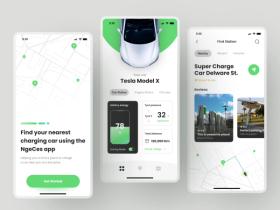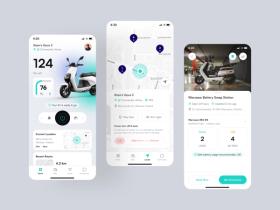Did you know the first car ever made was electric? Back in 1881, French engineer Gustave Trouvé introduced the world’s first electric tricycle, sparking a revolution in transportation. Fast forward to today, electric vehicles have evolved dramatically, shaping the future of mobility.
But what is e-mobility? This article will take you on a journey through the definition, features, and benefits of electric mobility, and explore its practical applications in our modern world.
Enjoy 🔥
🚘 What is Electric Mobility?
Electric mobility, or e-mobility, refers to the use of electric-powered vehicles and related technologies for transportation. This includes a variety of vehicles such as electric cars, buses, trucks, bikes, scooters, and even electric ships and planes. E-mobility also includes the necessary infrastructure for supporting these vehicles, such as charging stations, battery-swapping stations, and smart grids.
The core idea of e-mobility is transition from traditional fossil fuel-powered engines to more sustainable and environmentally friendly electric power sources.
The history of electric mobility is both fascinating and transformative. While early electric vehicles appeared in the late 19th century, real momentum began in the late 20th and early 21st centuries. In 1996, General Motors introduced the EV1, an all-electric car that sparked interest but was eventually discontinued.
The true breakthrough in the e-mobility meaning for people came with the launch of the Tesla Roadster in 2008, which demonstrated that electric vehicles could be high-performance and desirable. This period also saw significant investments in charging infrastructure and government incentives, paving the way for the modern electric mobility revolution.

Tesla Roadster 2008 demonstrates the potential for electric vehicles to deliver thrilling driving experiences while maintaining sustainability (image by Prem Jakati)
The rise of electric vehicles has been truly remarkable. By the end of 2024, the International Energy Agency (IEA) expects to see global sales of 17 million electric cars. The agency forecasts that electric vehicles will capture around 30 percent of the market by 2030, with an estimated 34 million e-cars on the road. This is a dramatic increase from just a few years prior, showcasing the rapid adoption of this technology.
To sum up, e-mobility definition encompasses the use of electric-powered vehicles and interconnected infrastructure to drive the electrification and modernization of transportation systems.
⚡ Key Features of the Electric Mobility Technology
Before discussing the key features of the emobility, our React Native developer, Cyril Troitsky, will explain the fundamental principles of how e-mobility operates.
Electric mobility technology centers around the efficient conversion of electrical energy into mechanical energy to power vehicles. The process begins with electrical energy stored in a rechargeable battery. An inverter then converts the battery's direct current (DC) into alternating current (AC), which drives the electric motor. The efficiency of this conversion directly impacts the vehicle's range; the more efficient it is, the farther a car can travel on a single charge.

EV drivers can effortlessly monitor their car's performance using a user-friendly app, ensuring optimal efficiency and a seamless driving experience (image by Timur A.)
The electric motor converts electrical energy into mechanical energy using magnetic fields. Effective BMS software development plays a key role in optimizing battery performance and ensuring seamless integration with the electric motor. These fields generate attractive and repellent forces, producing rotational motion that powers the vehicle.
Additionally, a crucial component of an electric vehicle is the DC-DC converter, which transforms the battery's high voltage (100-400 volts or more) into a lower voltage (12 or 48 volts) for use by electronic components. This multi-step process is the heart of how electric mobility technology functions.
Now, we know how electronic mobility works and can move to the key features of this fascinating technology.
Diverse Vehicle Options
E-mobility definition isn't limited to just cars. The spectrum of electric vehicles includes buses, trucks, motorcycles, scooters, and bicycles, offering diverse options for various transportation needs.
Electric buses and trucks are increasingly common in urban areas, reducing air pollution and greenhouse gas emissions. E-bikes and scooters are popular for short commutes and urban travel, providing an efficient and eco-friendly alternative to traditional vehicles. E-scooter app development plays a crucial role in the adoption of these electric vehicles, making urban mobility even more convenient and sustainable. Evaluating the Lime-like app development cost is essential for companies aiming to enter this market.

The diversity of electric vehicle options drives the development of convenient companion applications, enhancing user experience and vehicle management (image by Pasi Jormalainen)
E-mobility means of transportation encompasses a variety of vehicle types, each offering unique benefits and catering to different needs:
- Hybrid Electric Vehicles (HEVs). These vehicles use both an electric motor and an internal combustion engine. The battery is charged through regenerative braking and the engine itself. HEVs can switch between or combine the electric motor and combustion engine to optimize efficiency and performance.
- Plug-in Hybrid Electric Vehicles (PHEVs). PHEVs also combine an internal combustion engine with an electric motor, but they can be plugged in to recharge the battery. This allows for a certain distance of pure electric driving, reducing fuel consumption and emissions.
- Range-Extended Electric Vehicles (REEVs). REEVs primarily operate as electric vehicles but include an internal combustion engine that acts as a generator to recharge the battery, extending the vehicle's range. This setup alleviates range anxiety by ensuring that the vehicle can continue to operate even when the battery is low.
- Battery Electric Vehicles (BEVs). BEVs are fully electric vehicles powered solely by batteries. They produce zero tailpipe emissions and are typically recharged via external electric power sources. Advances in battery technology have significantly increased the range and efficiency of BEVs, making them a popular choice for those looking to minimize their environmental impact.
This diversity ensures that there is an electric option for almost every type of transportation requirement, from personal cars to public transport and commercial vehicles.
Charging Infrastructure
The growth of electric mobility depends heavily on the availability of robust charging infrastructure. Public and private charging stations are becoming more widespread, with fast-charging options significantly reducing the time needed to recharge an EV.
E-cars must be charged from a socket to stay mobile, which can be done at home. Standard home sockets can take at least eight hours to charge a vehicle, depending on the battery size fully. However, not all sockets are designed to handle the large amounts of electricity required for this duration. This issue is mitigated by installing dedicated charging stations at home, which can make recharging almost four times faster.

Efficient charging infrastructure supports widespread adoption of electric vehicles (image by Kiran)
Charging at public AC stations takes as long as home sockets. However, DC fast-charging stations can recharge a battery in about an hour due to direct current compatibility. The car's inverter converts AC from public grids, but DC fast chargers handle this conversion, significantly cutting charging time. Despite their efficiency, DC stations are rarer and costlier, needing special cables. Future tech like ultra-high-power chargers aims for 20-minute charges.
If you want to learn how innovative EV charging station apps can revolutionize the way we power our cars, read our comprehensive article on the topic:
Besides charging infrastructure, tires designed for electric vehicles can improve performance and range. For a deeper understanding, read this article about EV tires.
Lower Operating Costs
One of the significant features of electric vehicles is their lower operating costs. Electric motors are more efficient and have fewer moving parts compared to internal combustion engines, leading to reduced maintenance costs.

Lower operating costs in EVs make them a cost-effective choice for environmentally-conscious drivers (image by Nazmi Javier)
Additionally, understanding how to build a connected car app can help users monitor charging costs and optimize the cost of electricity for charging EVs, which is generally lower than the cost of gasoline or diesel. Small e-cars weighing less can achieve consumption rates below 7 kWh per 100 kilometers, while sub-compact and compact cars typically consume between 11 and 13 kWh per 100 kilometers.
Leveraging IoT in transportation, smart charging systems can dynamically adjust power distribution based on grid demand and vehicle needs.
Over the lifetime of the vehicle, these savings can be substantial, making electric vehicles a cost-effective option for many consumers. Choosing the best EV tires can further enhance these savings by improving energy efficiency and reducing wear.
Companion Apps
Companion apps enhance the electric vehicle ownership experience by providing a range of functionalities, including monitoring the vehicle's battery level, finding nearby charging stations, pre-conditioning the cabin temperature, and managing charging schedules. Evaluating the average PlugShare like app development cost is crucial for companies looking to create efficient and user-friendly EV apps.

Companion apps for electric vehicles offer users convenient features like vehicle monitoring from their smartphones (image by IndiaNIC Infotech)
These apps often integrate with navigation systems to help drivers locate charging stations along their routes and can provide real-time updates on the availability of chargers. Companion apps thus play a vital role in maximizing the convenience and efficiency of owning an electric vehicle.
If you’d like to know how to build EV companion app, you can read our guide:
Advanced Battery Technology
Advancements in battery technology are at the core of the electric mobility revolution. Modern batteries offer higher energy densities, faster charging times, and longer lifespans. Innovations like solid-state batteries promise even greater improvements, with increased safety and energy efficiency.

Advanced battery technology in electric vehicles enhances driving range, improves charging speed, and increases overall efficiency, making EVs more practical and appealing to consumers (image by Ilham Anugrah)
These advancements are crucial for extending the range of electric vehicles, reducing charging times, and lowering overall costs, thereby making electric mobility more accessible and practical for a broader audience.
Zero Emissions
One of the most compelling features of electric vehicles is their potential to significantly reduce emissions. EVs produce zero tailpipe emissions, which helps improve air quality, particularly in urban areas.

Electric vehicles are renowned for their zero emissions, contributing to cleaner air and reduced environmental impact (image by Nabila Al Khonsa)
When charged with electricity from renewable sources, electric vehicles can further reduce their overall carbon footprint, contributing to efforts to combat climate change. The shift to electric mobility is a critical step towards achieving a more sustainable and environmentally friendly transportation system.
In summary, electric mobility technology offers a range of key features that make it an attractive and viable alternative to traditional fossil fuel-powered transportation. From diverse vehicle options and robust charging infrastructure to lower operating costs, advanced battery technology, and zero emissions, electric mobility is poised to play a significant role in the future of transportation.
🔋 Benefits of Electric Mobility
Electric vehicles (EVs) are not just revolutionizing transportation; they are reshaping our world for the better. From cleaner air to economic savings, embracing electric mobility delivers a multitude of benefits.
Let’s take a moment to overview them 👇
Benefits of Electric Mobility
- Environmental Benefits. What is electro mobility for the environment? It significantly reduces air pollution and greenhouse gas emissions, contributing to cleaner air and mitigating climate change. By decreasing dependency on fossil fuels, EVs help preserve natural resources and reduce environmental degradation.
- Economic Benefits. EV owners enjoy lower fuel costs compared to gasoline or diesel vehicles, as electricity is generally cheaper and more stable in price. Moreover, EVs require less maintenance due to fewer moving parts, eliminating the need for oil changes, exhaust systems, and timing belts.
- Infrastructure and Technological Benefits. The infrastructure supporting electric vehicles, including charging stations, is rapidly expanding, enhancing convenience and accessibility. Advanced technology features and connectivity options improve user experience and integration with smart grids, supporting efficient energy use and grid stability.
- Social and Health Benefits. The shift to electric mobility improves public health by reducing air pollution, which is linked to respiratory and cardiovascular diseases. Additionally, lower noise levels from electric vehicles enhance urban quality of life, creating quieter and cozier cities.
- Strategic and Long-term Benefits. Electric vehicles play a crucial role in advancing renewable energy initiatives and integrating with smart grids. The development of EV technologies, including batteries and powertrains, drives innovation and economic growth, fostering new job opportunities in the EV sector. Moreover, the widespread adoption of EVs supports national and international climate goals, reducing carbon footprints and promoting sustainable transportation solutions.
These benefits underscore the transformative electric mobility meaning, paving the way for a cleaner, more sustainable future in transportation.
📌 You can learn more about these benefits at eMobility conferences, where industry leaders discuss such topics.
🔎 Use Cases of Electric Mobility
Emobilty is reshaping transportation paradigms globally, offering sustainable solutions across urban transport, logistics, and personal mobility. From bustling city centers to expansive logistics networks, electric vehicles are not just a trend but a transformative force driving toward a cleaner, quieter future.
If you’re wondering how to develop renewable energy software that supports this transition, we explain the key steps and technologies in the dedicated guide.

Considering the rising levels of air pollution and the depletion of oil and gas reserves across the world, E-mobility is likely to become a necessity within the next decades. So the sooner we make the switch, the better for us and the planet!
Cyril Troitsky, React Native Wizard @ Stormotion
Let's explore how electric mobility is making an impact in various sectors around the world!
Urban Transport
Electric mobility is revolutionizing urban public transport across the globe, offering cleaner and quieter solutions to city residents. In cities like London, electric buses have become a staple, contributing to reduced emissions and noise pollution.

Electric buses are transforming public transportation by providing a zero-emission, quiet, and efficient alternative to traditional diesel-powered buses (image by Adam Ogrodnik)
According to the Transport for London (TFL) Commissioners’ report, London's fleet of 950 zero-emission busses is one of the largest in Europe, with plans to expand further by 2025. These buses not only improve air quality but also demonstrate the scalability of electric vehicles in mass transit systems.
Personal Mobility
Electric mobility is transforming personal transportation options worldwide, from cars to bicycles.
Statzon reports that countries like Germany, France, and the United Kingdom lead Europe in electric vehicle adoption. Germany saw over 520,000 BEVs and 173,000 PHEVs registered in 2023. France followed with significant growth, registering nearly 700,000 BEVs and 170,000 PHEVs, while the UK registered over 314,000 BEVs and approximately 142,000 PHEVs.
Norway leads the charge with the highest per capita adoption of electric vehicles. In the country, electric cars enjoy extensive incentives such as tax exemptions and toll road waivers, incentivizing rapid adoption among consumers. Starting in 2025, Norway will only permit the sale of zero-emission cars.

EV rental apps are popular options for people seeking eco-friendly transportation solutions (image by Angry Nerds)
Similarly, electric two-wheelers are gaining popularity in densely populated cities like New Delhi and Beijing, offering affordable and eco-friendly alternatives to conventional gasoline-powered vehicles.
Moreover, electric vehicle (EV) rental services are gaining popularity worldwide, offering environmentally friendly transportation options that cater to both short-term travelers and eco-conscious consumers. If you want to know how to build an EV rental app and choose the effective business model, you can read our article on this topic:
Logistics and Freight
Electric mobility is increasingly making its mark in logistics and freight, particularly with the advent of electric trucks and vans. Companies such as DHL are investing heavily in electrifying their delivery fleets, showcasing the feasibility and cost-effectiveness of electric vehicles in commercial operations. By 2030, DHL plans for electric vehicles to manage 60% of their pick-ups and deliveries.
Moreover, initiatives in the United States, like California’s Advanced Clean Trucks regulations, are paving the way for the widespread adoption of electric heavy-duty vehicles (HDVs), reducing carbon footprints in freight transportation.
These examples illustrate the diverse applications of electric mobility across different sectors, underscoring its role in building sustainable urban environments and reducing global carbon emissions.
⚙️ E-Mobility Ways of Implementation: Expertise from Stormotion
What is e-mobility for Stormotion? It’s the ability to help clients bring their sustainable and energy-efficient ideas to life. We have extensive expertise in EV and IoT software development services. Let’s talk about our e-mobility case studies with Cyril Troitsky.
One of the recent projects we’ve worked with was Egret, a leading e-scooter manufacturer based in Hamburg. Faced with the challenge of transitioning their app infrastructure from Native to React Native, Egret encountered significant OTA update delays, causing up to five-minute lags that posed safety concerns.

Egret app allows users to set up and monitor the performance of their e-scooters (image by Stormotion)
To resolve this, our team developed a custom native module that integrated all necessary Bluetooth functionalities, improving communication speed and consistency across all e-scooter models. This solution not only addressed the update delays but also ensured seamless app-to-scooter interactions, reinforcing Egret's commitment to delivering top-tier e-mobility experiences.
DeftPower is another project we’re proud of. The DeftPower white-label solution is designed to enhance the experience for EV drivers, from locating charging stations to monitoring the charging process and managing charging history.
We worked on adding and improving complex custom features like personalized sign-up processes and a comprehensive list of supported cars to the existing app. Additionally, we improved the user interface, adding animations on location overview and history screens further enhancing user engagement and satisfaction.

The DeftPower app allows drivers to find charging stations and check the charging process (image by Stormotion)
The implementation of Deftpower essentially consists of three major parts:
- The backend that communicates with charging stations via the OCPI protocol and gets data from them.
- The customer portal which allows the customer to customise their app (change colors, features, icons etc.)
- The mobile app that communicates with the backend and the portal to get it’s configuration, as well as data about vehicles, users and their charging stations. This is the part that Stormotion has worked extensively for the past 2 years, having helped in implementing such features as EV routing, optimised charging and subscriptions.
One challenge there had to do with Deftpower’s white-label set up: because there are numerous client apps, each with their own configuration, we needed to implement a solution that would be as customisable as possible. To develop that we co-created a custom pipeline that retrieves configurations from the portal, adjusts the icons, fetches the translations etc. and combines it all to build a tailored app for each of the clients.
The other notable example is Norsk Guardian. It’s a cutting-edge app developed for a company specializing in lithium-ion batteries for marine activities. Our team undertook the challenge of creating an app capable of simultaneously monitoring multiple lithium-ion batteries, retrieving crucial telemetry data, and displaying comprehensive charging indicators.

The Norsk Guardian app helps users monitor real-time data from their marine batteries (image by Stormotion)
With its unique Bluetooth module, Norsk Guardian provides real-time data on battery temperature, voltage, and current charge, alerting users to potential issues before they become critical. This robust system ensures instant data exchange and reliable warnings, helping users avoid dangerous situations at sea.
We're excited to share this firsthand account of the value we delivered on Norsk Guardian!
💡 Takeaways
Let’s recap the information about electric mobility:
- Emobility definition encompasses the use of electric-powered vehicles and related technologies for transportation. E-mobility offers diverse options from cars to ships, supported by robust charging networks and smart grids.
- Key features include diverse vehicle options, charging infrastructure, lower operating costs, EV companion apps, advanced battery technologies, and zero emissions, making it not only economically viable but also environmentally sustainable.
- The benefits span cleaner air, quieter cities, and economic savings for consumers and businesses alike.
- Across urban transport, logistics, and personal mobility, electric vehicles continue to evolve, promising a cleaner, greener tomorrow.
If you have questions about implementing e-mobility solutions in your projects, contact us today! Let’s collaborate to create a cleaner, more sustainable world together!


![Stormotion client David Lesser, CEO from [object Object]](/static/93e047dadd367691c604d8ffd1f54b58/b0e74/david.png)


